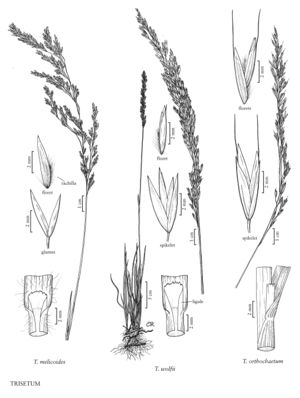Difference between revisions of "Trisetum melicoides"
FNA>Volume Importer |
FNA>Volume Importer |
||
| Line 7: | Line 7: | ||
|synonyms={{Treatment/ID/Synonym | |synonyms={{Treatment/ID/Synonym | ||
|name=Trisetum melicoides var. majus | |name=Trisetum melicoides var. majus | ||
| − | |authority= | + | |authority= |
| + | |rank=variety | ||
}} | }} | ||
|hierarchy=Poaceae;Poaceae subfam. Pooideae;Poaceae tribe Poeae;Trisetum;Trisetum melicoides | |hierarchy=Poaceae;Poaceae subfam. Pooideae;Poaceae tribe Poeae;Trisetum;Trisetum melicoides | ||
| Line 20: | Line 21: | ||
-->{{Treatment/Body | -->{{Treatment/Body | ||
|distribution=Maine;N.H.;Vt.;Mich.;Wis.;N.Y.;N.B.;Nfld. And Labr. (Labr.);N.S.;Ont.;Que. | |distribution=Maine;N.H.;Vt.;Mich.;Wis.;N.Y.;N.B.;Nfld. And Labr. (Labr.);N.S.;Ont.;Que. | ||
| − | |discussion=<p>Trisetum melicoides is a native species that grows on moist, cool stream banks, gravelly shores, shaded rock ledges (especially calcareous ones), and in damp woods. It grows only in southeastern Canada and the northeastern United States. It is listed as endangered in Wisconsin, New York, and Maine. Plants with pilose sheaths have been called T. melicoides var. majus (A. Gray) Hitchc, but the trait varies within populations.</p> | + | |discussion=<p><i>Trisetum melicoides</i> is a native species that grows on moist, cool stream banks, gravelly shores, shaded rock ledges (especially calcareous ones), and in damp woods. It grows only in southeastern Canada and the northeastern United States. It is listed as endangered in Wisconsin, New York, and Maine. Plants with pilose sheaths have been called <i>T. melicoides</i> <i></i>var.<i> majus</i> (A. Gray) Hitchc, but the trait varies within populations.</p> |
|tables= | |tables= | ||
|references= | |references= | ||
| Line 29: | Line 30: | ||
-->{{#Taxon: | -->{{#Taxon: | ||
name=Trisetum melicoides | name=Trisetum melicoides | ||
| − | |||
|authority=(Michx.) Scribn. | |authority=(Michx.) Scribn. | ||
|rank=species | |rank=species | ||
| Line 37: | Line 37: | ||
|family=Poaceae | |family=Poaceae | ||
|illustrator=Cindy Roché | |illustrator=Cindy Roché | ||
| + | |illustration copyright=Utah State University | ||
|distribution=Maine;N.H.;Vt.;Mich.;Wis.;N.Y.;N.B.;Nfld. And Labr. (Labr.);N.S.;Ont.;Que. | |distribution=Maine;N.H.;Vt.;Mich.;Wis.;N.Y.;N.B.;Nfld. And Labr. (Labr.);N.S.;Ont.;Que. | ||
|reference=None | |reference=None | ||
| Line 42: | Line 43: | ||
|publication year= | |publication year= | ||
|special status= | |special status= | ||
| − | |source xml=https:// | + | |source xml=https://jpend@bitbucket.org/aafc-mbb/fna-data-curation.git/src/f50eec43f223ca0e34566be0b046453a0960e173/coarse_grained_fna_xml/V24/V24_1056.xml |
|subfamily=Poaceae subfam. Pooideae | |subfamily=Poaceae subfam. Pooideae | ||
|tribe=Poaceae tribe Poeae | |tribe=Poaceae tribe Poeae | ||
Revision as of 21:17, 16 December 2019
Plants perennial, with both fertile and sterile shoots; cespitose. Culms (20)40-80(100) cm, erect, smooth or scabridulous. Leaves concentrated below midlength on the culms; sheaths glabrous or pilose; ligules 1.5-3.5 mm, rounded or truncate; blades 10-20+ cm long, 2-9 mm wide, flat, lax. Panicles 8-20 cm long, usually 2-4 cm wide, lax, nodding, silvery-green or tan; lower branches to 5 cm, ascending, naked below, the spikelets imbricate distally. Spikelets 5-7(9) mm, pedicellate, lance-ovate, with 2(4) florets; rachilla internodes and hairs 1.3-2 mm. Glumes unequal, widest at or below the middle; lower glumes 4-5.5 mm; upper glumes 5-7 mm long, nearly as long as the florets, wider than the lower glumes; callus hairs 1.5-2 mm; lemmas 5-6 mm, smooth or scabridulous, apices usually minutely bifid, sometimes entire, unawned or awned. awns to 2 mm, arising just below and rarely exceeding the apices; paleas shorter than the lemmas; anthers 0.6-0.8 mm. Caryopses about 3 mm, sparsely pubescent distally. 2n = 14.
Distribution
Maine, N.H., Vt., Mich., Wis., N.Y., N.B., Nfld. And Labr. (Labr.), N.S., Ont., Que.
Discussion
Trisetum melicoides is a native species that grows on moist, cool stream banks, gravelly shores, shaded rock ledges (especially calcareous ones), and in damp woods. It grows only in southeastern Canada and the northeastern United States. It is listed as endangered in Wisconsin, New York, and Maine. Plants with pilose sheaths have been called T. melicoides var. majus (A. Gray) Hitchc, but the trait varies within populations.
Selected References
None.
